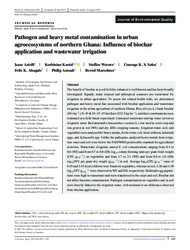Pathogen and heavy metal contamination in urban agroecosystems of northern Ghana: Influence of biochar application and wastewater irrigation
Asirifi, Isaac
Kaetzl, Korbinian
Saba, Courage K. S.
Abagale, Felix K.
Amoah, Philip
Marschner, Bernd
DOI: https://doi.org/10.1002/jeq2.20260
Persistent URL: http://resolver.sub.uni-goettingen.de/purl?gldocs-11858/9914
Persistent URL: http://resolver.sub.uni-goettingen.de/purl?gldocs-11858/9914
Asirifi, Isaac; Kaetzl, Korbinian; Werner, Steffen; Saba, Courage K. S.; Abagale, Felix K.; Amoah, Philip; Marschner, Bernd, 2021: Pathogen and heavy metal contamination in urban agroecosystems of northern Ghana: Influence of biochar application and wastewater irrigation. In: Journal of Environmental Quality, Band 50, 5: 1097 - 1109, DOI: 10.1002/jeq2.20260.
 |
Dokument öffnen: |
The benefit of biochar as a soil fertility enhancer is well known and has been broadly investigated. Equally, many tropical and subtropical countries use wastewater for irrigation in urban agriculture. To assess the related health risks, we determined pathogen and heavy metal fate associated with biochar application and wastewater irrigation in the urban agriculture of northern Ghana. Rice (Oryza L.) husk biochar (20 t ha−1), N–P–K 15–15–15 fertilizer (212.5 kg ha−1), and their combinations were evaluated in a field‐based experiment. Untreated wastewater and tap water served as irrigation water. Red amaranth (Amaranthus cruentus L.) was used as a test crop and was grown in wet (WS) and dry (DS) cropping seasons. Irrigation water, soil, and vegetables were analyzed for heavy metals, Escherichia coli, fecal coliform, helminth eggs, and Salmonella spp. Unlike the pathogens, analyzed heavy metals from irrigation water and soil were below the FAO/WHO permissible standard for agricultural activities. Wastewater irrigation caused E. coli concentrations ranging from 0.5 to 0.6 (WS) and from 0.7 to 0.8 (DS) log10 colony forming units per gram fresh weight (CFU gFW−1) on vegetables and from 1.7 to 2.1 (WS) and from 0.6 to 1.0 (DS) log10CFU per gram dry weight (gDW−1) in soil. Average log10CFU gFW−1 rates of 6.19 and 3.44 fecal coliform were found on vegetables, whereas in soil, 4.26 and 4.58 log10CFU gDW−1 were observed in WS and DS, respectively. Helminth egg populations were high in wastewater and were transferred to the crops and soil. Biochar did not affect bacteria contamination. Pathogen contamination on vegetables and in soil were directly linked to the irrigation water, with minimal or no difference observed from biochar application. Core Ideas:
Soil and vegetable contamination were linked to irrigation water source.
Rice husk–derived biochar did not affect bacteria contamination on vegetables.
Wastewater and biochar application did not affect heavy metal contamination in soil.
Helminth eggs and bacteria pathogens in soil were not significantly affected by biochar.
Statistik:
ZugriffsstatistikSammlung:
Schlagworte:
northern Ghanaagroecosystems
wastewater irrigation
pathogen contamination
heavy metal contamination
influence of biochar application
This is an open access article under the terms of the Creative Commons Attribution‐NonCommercial‐NoDerivs License, which permits use and distribution in any medium, provided the original work is properly cited, the use is non‐commercial and no modifications or adaptations are made.

